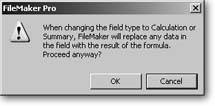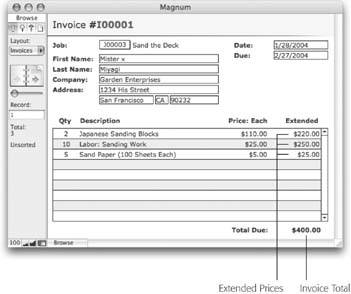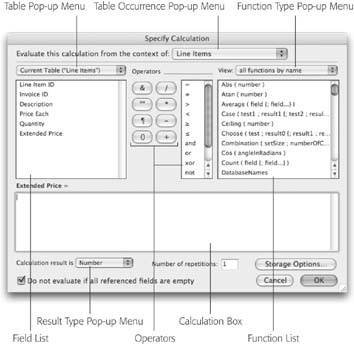Understanding Calculations
A calculation is a mathematical formula: It shows how different things combine to come up with an answer. But even if you hated algebra class, don't close the book yet! Instead of the Xs, Ys, and Zs of the math world, FileMaker lets you use your own fields to supply your formula with dataa much more intuitive approach.
FileMaker calculations can also do more than just math. For starters, you can do calculations on time, date, timestamp, container, and text fields, too. (See the box on Section 9.2 for an example.) Way back in Chapter 3, you learned that FileMaker can create calculation fields (Section 3.2.6.5). Calculation fields work just like any other FileMaker field, except that you can't type data into them. Instead, they use a calculation to determine their own value.
You can use a calculation field just like any other field: Put it on a layout, use it in Find mode, and even use it in other calculation fields. But as a calculation field, its value always stays up-to-date automatically. If the price or quantity changes, the calculation updates the data in your field without your doing anything. Figure 9-1 shows where calculation fields could benefit your invoices layout.
|
Furthermore, calculations aren't limited to working inside fields. Once you understand the basic concept of calculations, you gain all kinds of new FileMaker skills. For example, you can use calculations with the Records  Replace Field Contents command (Section 2.3). Instead of replacing the data in every record with the 9.1.1. Creating a Calculation
Replace Field Contents command (Section 2.3). Instead of replacing the data in every record with the 9.1.1. Creating a Calculation
A simple example speaks more loudly than several pages of explanation, so you start off by adding a calculation to an existing number field to the database you built in Chapters 7 and 8. As your database now stands, when you add line items to an invoice, you have to type the quantity, price for each item, and the extended price, as shown in Figure 9-1. But since the extended price is always the price times the quantity, why not let FileMaker handle the repetitive work while you do the creative stuff?
Note: To work through the examples in this chapter, you can download the Customers database from the "Missing CD" page at www.missingmanuals.com.
Here's how you add a calculation to a number field:
- In the Customers database, choose File
 Define Database, and make sure youre on the Fields tab. From the Table pop-up menu, choose Line Items.
Define Database, and make sure youre on the Fields tab. From the Table pop-up menu, choose Line Items.
That's the table with your Extended Price field in it.
- In the field list, select the Extended Price field. From the Type pop-up menu, choose Calculation; then click Change.
FileMaker warns you that when it converts the field, it changes (read: deletes) any information already in the field. See Figure 9-2.

Figure 9-2. This warning is serious. Your new calculation overwrites existing data. But even if you write a calculation, there's a way out, so long as you haven't OK'd the Define Database dialog box. Just click its Cancel button and you'll get the chance to discard all the changes you've made in the dialog box.
- Click OK.
As shown in Figure 9-3, FileMaker asks you what calculation you have in mind.
- In the Calculation Box, type Price Each * Quantity.
The calculation box holds the calculation itself. In this case, you've just added a brand-new calculation that multiplies the contents of the Price Each by the contents of the Quantity field.
- In the Define Database window, click OK, and then OK again.
You're now back in your database. Switch to the Invoices layout and add a line item. You see that the Extended Price field updates automatically to reflect the proper price.
Tip: If FileMaker complains about not being able to find a field when you click OK, check the spelling of your field names.
|
Part I: Introduction to FileMaker Pro
Your First Database
- Your First Database
- An Very Quick Database Tour
- Creating a New Database
- Opening and Closing Database Files
- Saving Your Databases
- Adding Records to Your Database
- Navigating Your Database
- Same Database, Multiple Windows
Organizing and Editing Records
- Organizing and Editing Records
- Views
- Advanced Find Mode
- Changing Multiple Records
- Sorting Records
- Editing Whats in Your Fields
- Paragraph Formatting
- Beyond Text: Container Fields
- Checking Spelling
- Printing and Preview Mode
Building a New Database
- Building a New Database
- Tables and Fields
- Defining Fields
- Advanced Field Options
- Bringing It All Together
Part II: Layout Basics
Layout Basics
Creating Layouts
Advanced Layouts and Reports
- Advanced Layouts and Reports
- Setting up Field Controls
- Adding Field Controls to Layouts
- Field Behavior
- Tab Order
- Print-Related Layout Options
- Format the Number/Date/Time/Graphic
- Adding Buttons
- Tab Panels
- Reports and Summary Fields
Part III: Multiple Tables and Relationships
Multiple Tables and Relationships
- Multiple Tables and Relationships
- Relational Databases Explained
- Modeling Your Database
- Creating a Relational Database
- Relational Databases
Advanced Relationship Techniques
- Advanced Relationship Techniques
- Creating Related Records
- Table Occurrences
- Managing Data with Data Tunneling
- Building a Data Tunneling Interface
- Connecting Databases
- Lookups
- Advanced Relationships
Part IV: Calculations
Introduction to Calculations
- Introduction to Calculations
- Understanding Calculations
- The Structure of a Calculation
- Creating a Calculation Field
- Auto-Enter Calculations
- Validate Data Entry with a Calculation
- Replacing Data Using a Calculation
- Comments
Calculations and Data Types
- Calculations and Data Types
- Number Crunching Calculations
- Going Beyond Basic Calculations
- Text Parsing Calculations
- Date and Time Calculations
- Containers in Calculations
Advanced Calculations
- Advanced Calculations
- Stored, Unstored, and Global Fields
- Logical Functions
- The Let Function and Variables
Extending Calculations
Part V: Scripting
Scripting Basics
- Scripting Basics
- Your First Script
- The Importance of the Layout
- Running Scripts
- Branching and Looping in Scripts
Script Steps
- Script Steps
- Go to Layout
- Scripting for Fields
- Working with Records
- Finding Records
- Sorting Records
- Working with Windows
- Working with Files
- Printing
- Other Script Steps
Advanced Scripting
- Advanced Scripting
- Commenting Scripts
- Asking and Telling the User
- Organizing Complex Scripts
- Handling Errors
- Putting a Complex Script Together
Part VI: Security and Integration
Security
Exporting and Importing
- Exporting and Importing
- Exporting a File
- Export Formats
- Importing Data
- Import Data Sources
- Importing and Exporting in a Script
Sharing Your Database
- Sharing Your Database
- FileMaker Network Sharing
- Sharing Over the Internet
- FileMaker Server
- Server Hardware
Developer Utilities
- Developer Utilities
- Script Debugger
- Disable Script Steps
- The Database Design Report
- Tooltips
- Copying Database Structure
- Custom Menus
- Developer Utilities
- File Maintenance
Part VII: Appendixes
Appendix A. Getting Help
EAN: 2147483647
Pages: 176


